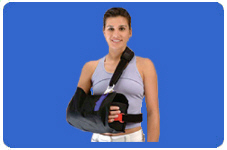
Typical shoulder surgery recovery.
As a doctor, recooperation from shoulder surgery can be tough. The problem is that the severe degree of immobilization that’s needed (that big blue pillow) makes that arm/hand useless. Is there a better way? Well, if you have a rotator cuff tear, newer and much less invasive methods of treatment may be the answer, as with less trauma from the procedure comes quicker recovery times (read no blue pillow). How can this be possible? Trade the scapel for a needle. Rather than trying to sew ligaments back together or sewing a torn rotator cuff tendon, get stem cells to repair the damge. The doctor simply places the cells in the damaged area with an injection. Little trauma, little recovery. Sounds like science fiction? Not really, as this procedure using your own stem cells to repair the damage is now being used reduce recooperation times. No surgery, less recovery. To learn more, click the video below:
